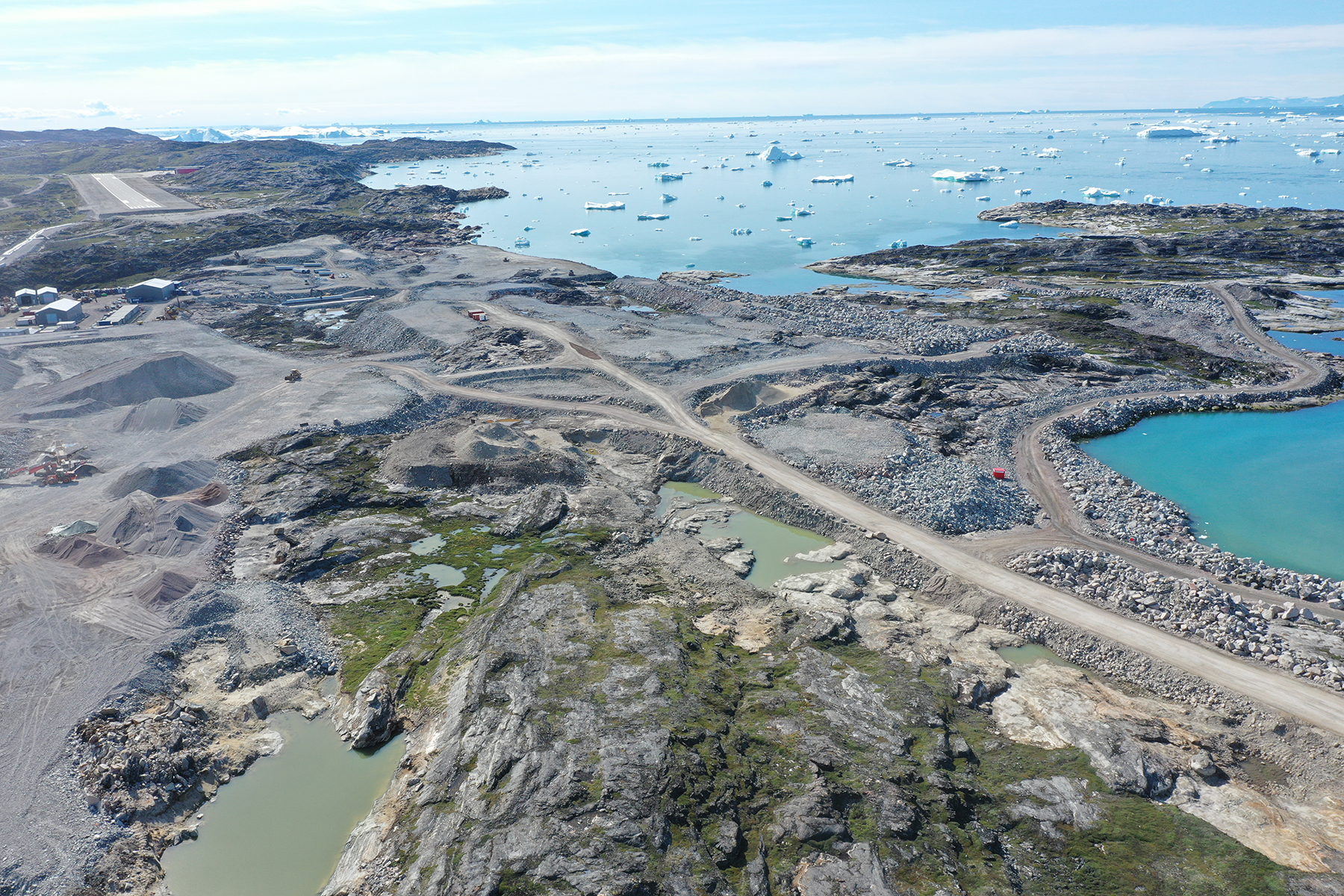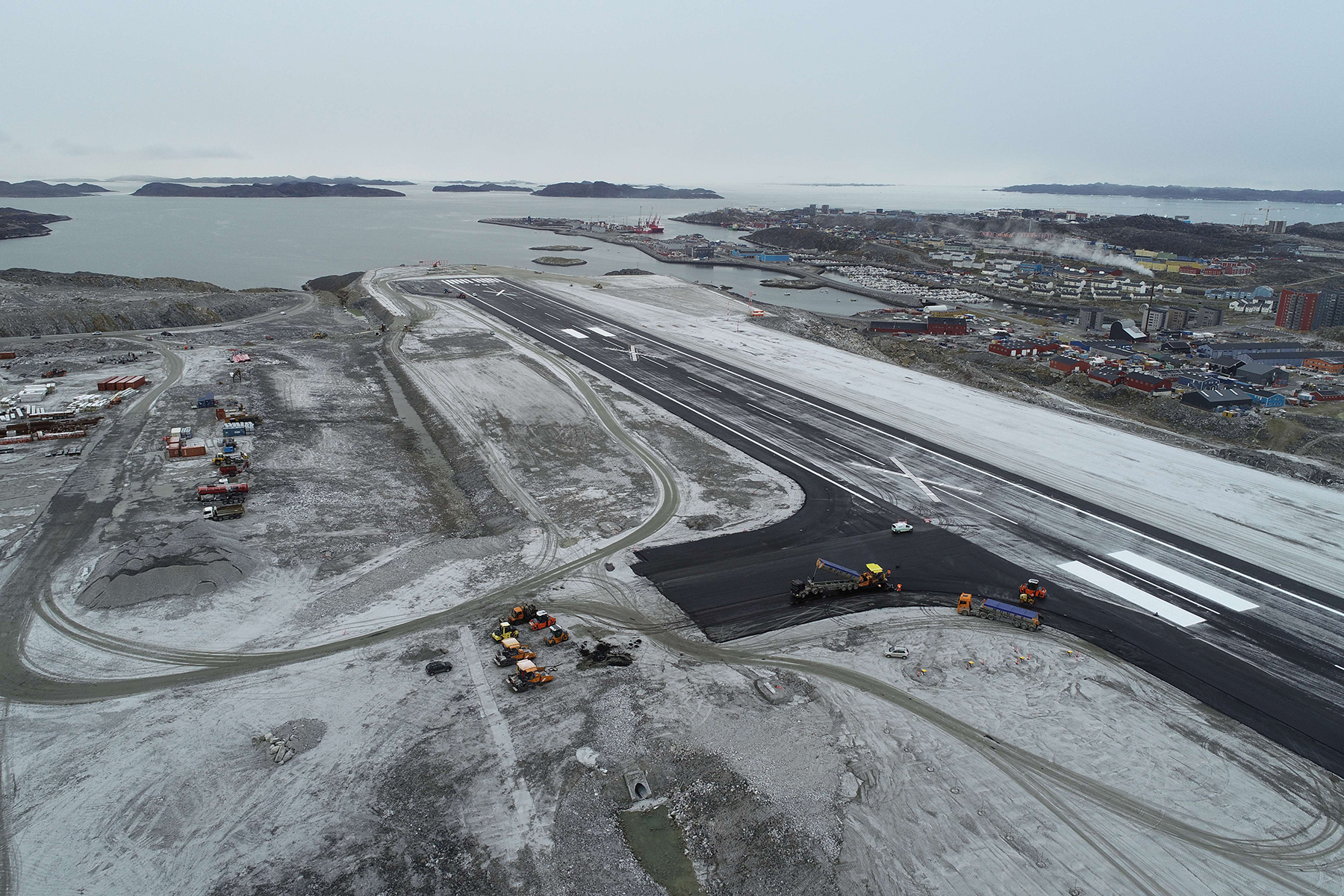By Jay Landers
Historically, travel to and within Greenland has been a challenge, given its remote location and the rugged terrain that prevents the construction of roadways between its cities and towns. At the same time, existing airports are small and offer only limited service at the regional level. However, three new airports under construction are expected to improve Greenland’s international transportation connections while also offering greater domestic air service within the island nation.
‘Game changer for Greenland’
A massive island, the interior of which is composed mainly of glaciers, Greenland has a population of approximately 57,000 residents. “It's quite a big island, and it's only populated scarcely around the coast,” says Aviaaja Karlshøj Knudsen, the project director for Kalaallit Airports Holding A/S, the company overseeing the efforts to construct the three new airports in Greenland. “None of the settlements or cities are connected with roads,” Knudsen says. “So, you have to either fly or go by boat.” Greenland’s existing airports support the use of relatively small aircraft, necessitating connecting flights to travel between most population centers, she says.
Kalaallit Airports is constructing airports in the Greenland cities of Nuuk, Ilulissat, and Qaqortoq. The capital and home to roughly one-quarter of Greenland’s residents, Nuuk is situated on the southwest coast. Ilulissat, in western Greenland, is approximately 560 km north of Nuuk by plane and home to roughly 4,700 people. Meanwhile, Qaqortoq, in southern Greenland, is about 480 km south of Nuuk by plane and home to some 3,100 people.

The new airports are expected to improve travel options for visitors to Greenland as well as for residents looking to travel within the enormous country. “This is going to be a game changer for Greenland,” Knudsen says.
Tourism is expected to grow significantly as a result of the new airports. “It’s going to be a lot easier to travel back and forth from Greenland,” Knudsen says. Flights from Greenland will be able to connect to larger airports in North America and Europe. “This is going to lift up tourism greatly,” she says. “There are really big expectations.”
New facilities
The international airports at Nuuk and Ilulissat will each feature a 2,200 m long runway, a taxiway, a new control tower, a terminal area with an apron and building plots for terminal and service buildings, and parking in the terminal area. Both airports are scheduled to open in 2024
The smaller regional airport at Qaqortoq will feature a tower and a 1,500 m long runway, which will be positioned in a manner that will enable it to be extended up to 1,799 m in the future. The terminal will have an area of approximately 2,000 sq m. The Qaqortoq airport will be operational in fall 2025.
Formed by the Greenland government, Kalaallit Airports Group comprises three companies: Kalaallit Airports Holding A/S; Kalaallit Airports International A/S, which is responsible for constructing the new airports at Nuuk and Ilulissat; and Kalaallit Airports Domestic A/S, which is constructing the Qaqortoq airport. The Greenland government owns two-thirds of Kalaallit Airports International, while the Danish government owns the remaining one-third.
Massive blasting
With its paucity of flat terrain, mountainous Greenland does not afford much readily available room for airports. As a result, a significant component of the construction process involves blasting inordinate volumes of rock, mostly granite and gneiss, and reconfiguring the material to provide flat spaces on which to build the runways and other airport infrastructure.
In both Nuuk and Ilulissat, 6 million cu m of rock require blasting, a volume that Knudsen likens to a “soccer field, 1 1/2 km in the air.” For the Qaqortoq project, 2 million cu m of rock must be blasted. The rock material, which is used on-site as fill, is ground down as necessary to create the required sizes.
The vast scale of the blasting and filling has been among the main challenges of the airport projects, Knudsen says. “It's just untried in Greenland before.”

Tricky construction
Nuuk is at the edge of a peninsula, with water to the west and mountains to the east, leaving little room for major construction. The other suitable places for the new airport near Nuuk would have been on land separated from the capital by a fjord or on islands to the south, Knudsen says. However, these locations could not reasonably be connected by bridge or tunnel to the capital, and it was not desirable to force travelers to take a ferry from the airport to the city.
Because of these space constraints, the new airport is being constructed “in the middle of the city,” Knudsen says. “We’re almost splitting the city in two with this new airport.”
The new international airport in Nuuk is being constructed essentially on top of the city’s existing regional airport. Because the existing airport must remain operational during the project, the construction of the new facility is a “little tricky,” Knudsen says.
The Munck Group — the contractor constructing the runways at Nuuk and Ilulissat — completed construction of the first half of the new runway at Nuuk in early November and moved air traffic to it from the existing runway. It was an “exciting milestone” for the project, Knudsen says.

Next steps in the construction process will entail shutting down the existing runway, removing the existing pavement, and changing some of the fill material at the site. “Then we’re going to build the rest of this new 2,200 m runway,” Knudsen says. The existing terminal is expected to be shut down by the end of next year, once the new terminal is ready for operation.
In Ilulissat, the new international airport is being constructed immediately north of its existing regional counterpart. “The existing airport is going to be operational until the new airport is finished, and then it's going to be shut down,” Knudsen says. Once that happens, the existing runway will become part of the access road leading to the new airport.
The runways at Nuuk and Ilulissat were designed by the Danish firm COWI, which also designed the terminals with ZESO Architects. MT Højgaard is constructing the buildings at Nuuk, while KJ Greenland is constructing the buildings at Ilulissat. Inuplan A/S is providing construction supervision and inspection services for the Nuuk and Ilulissat airports.
Huge investments
The Qaqortoq airport will be approximately 6.5 km away from the town of Qaqortoq by vehicle. The regional airport will service all types of aircraft used internally within Greenland as well as aircraft used to fly to nearby overseas destinations such as Iceland and the town of Iqaluit in the Canadian territory of Nunavut.
Pennecon Heavy Civil won the project tender and started in February 2022 to construct the new runway and conduct additional terrain work for the Qaqortoq facility. Additional work to be conducted will include site preparations for the terminal construction, taxiway, airfield, public parking areas, and completion of the access road to Qaqortoq, according to a news release from Kalaallit Airports Group issued in February. Rambøll Group A/S is providing the construction supervision.
All told, the Nuuk and Ilulissat airports will cost an estimated 3.7 billion Danish krones ($495 million), while the Qaqortoq airport has an estimated cost of 1 billion Danish krones ($134 million), Knudsen says. Given Greenland’s rugged terrain and small population, the investments in the new airport infrastructure “are huge for the country,” she says.



